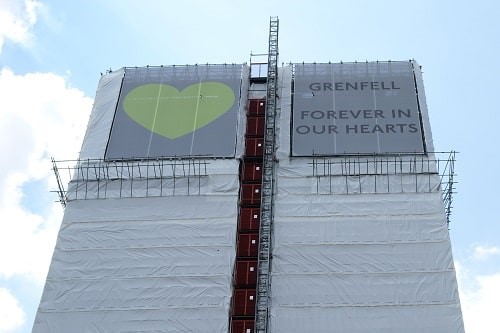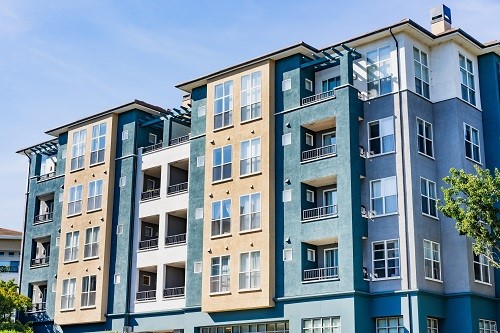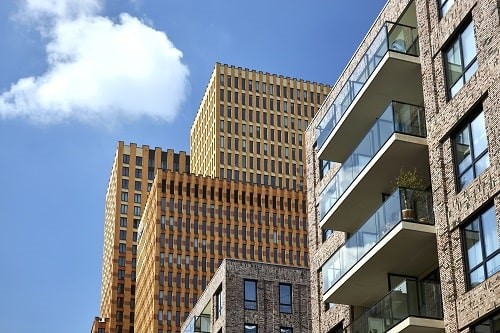On the sixth anniversary of the Grenfell Tower fire, 2023 has seen a significant rollout of legislative changes to fire safety in high-rise residential buildings that highlight the progress made and the challenges that yet remain.
Features
Progress made and challenges ahead – Grenfell six years on
Parallel to ongoing news reports about other high-rise residential buildings with similar internal and external fire safety defects, England has seen updates to the legislative guidance of Approved Document B, a government consultation on second staircases in buildings over 30 metres high, mandatory remediation contracts for house builders and developers, a building safety levy to protect taxpayers and leaseholders from remediation costs, and the introduction of the Building Safety Regulator (BSR), with Wales and Scotland also detailing their plans for fire safety remediation of high-risk residential buildings.
All of this is in the wake of the tragic fire on 14 June 2017 that saw 129 residential flats of a 24-storey building destroyed and resulted in 72 people losing their lives.
 Combustible cladding and failed compartmentation have proven to be only the beginning of the fire safety deficiencies identified in the Grenfell Tower Inquiry. Photograph: iStock
Combustible cladding and failed compartmentation have proven to be only the beginning of the fire safety deficiencies identified in the Grenfell Tower Inquiry. Photograph: iStock
While these changes are necessary to ensure better fire safety and protection for residents of high-rise buildings, the fire safety sector continues in its drive to ensure those buildings at greater risk of fire have the necessary preventative measures in place, with much of the industry insisting that more needs to be done.
As reported by Sir Martin Moore-Bick in his Phase 1 report on the Grenfell Tower fire, revelations from the Inquiry have been particularly damning, with combustible cladding and failed compartmentation proving to be only the beginning of the fire safety deficiencies identified. From developers and contractors to property management companies, to the local councils, to the fire and rescue services – failures have been discovered across the board, and sadly, they are not limited to Grenfell.
Even prior to the 2017 fire, awareness of inadequate fire safety practices had been slowly building from other tragedies such as Lakanal House in 2009, in which six people died, along with news of international fires at high-rises using the same unsafe cladding material as Grenfell. Hindsight, however, is proving a bitter pill to swallow. As the industry debates roll on, Grenfell’s Bereaved family members, Survivors, and local Residents (collectively known as BSRs), keep vigil while they await the full report from the second part of the Inquiry.
Responding to the progress so far, deputy managing director of the Fire Protection Association, Howard Passey, said: “In the June 2023 progress update on the implementation of recommendations from the Phase 1 Inquiry report issued by the Home office and MHCLG it is stated that ‘whilst headlines may not have changed significantly since the last update there has been definite progress’ and there’s no doubt that this is the case.
“However, it has to be recognised that progress has been slow with other indications suggesting that the changes in industry behaviours required to underpin the legislative drivers are yet to be evidenced consistently. New legislation is implementing complex changes which present challenges to all involved in the construction sector, not just those involved in high-rise residential buildings and whilst change is of course essential, the pace and complexity need to be better balanced.”
Inquiry status
On 2 May 2023, the Inquiry team announced that the draft version of its second and final report would not be completed until the end of the year. With it then intended for a final review by the Prime Minister, the approved publication will not, in fact, be ready until 2024.
The Inquiry team stated. “We recognise that everyone involved in the Inquiry wants the report to be published as soon as possible and we fully understand the importance that has for them and for the wider public.
However, it is also important that, as what we hope will be regarded as the definitive version of events, the report is complete and accurate. Individual chapters are at different stages of drafting and several stages still remain to be completed. “We also want its recommendations to be as effective as possible, which means they must have a firm basis. We have asked a number of the Inquiry’s expert witnesses for their suggestions.”
It is believed that once the report is published, criminal prosecutions against those deemed to be responsible will also begin – something that has been long anticipated. In the meantime, 900 of Grenfell’s Bereaved family members, Survivors and local Residents (BSRs) have at least reached a successful settlement of civil claims against 22 parties involved in the construction, development, and management of Grenfell, including Arconic (the cladding manufacturer), Saint Gobain (parent company of Celotex, an insulation manufacturer), Kingspan (another insulation manufacturer), and Rydon (the main contractor). The high court settlement took place in April 2023, with media outlets revealing that the payout figure was over £150 million.
At the time, a spokesperson for Arconic said that alongside the settlement, it has agreed to “contribute to a restorative justice project to benefit the community affected by the fire”.
“Arconic continues to express its deepest sympathy to the Grenfell residents and their families, and appreciates the importance of this milestone for providing a resolution that lessens the delay and stress to claimants that would result from protracted legal proceedings.”
As reported by Construction News, the total expenditure of the Grenfell Tower Inquiry to date has reached £170 million, with 41 per cent of this (£69.7 million) directed towards lawyers’ fees for “core participants”, including victims, family members of the bereaved, cladding installers and subcontractors, and the Fire Brigades Union. Remuneration and legal costs have also reached £28.2 million. Notably, the figures do not include costs for participation by the London Fire Brigade, the Royal Borough of Kensington and Chelsea, or the legal representation taken by private companies (Kingspan, Celotex, and Rydon Construction).
Legislative changes
In lieu of government changes, councils throughout England have been working to identify those tall buildings with defective external wall systems or unsafe cladding in need of remediation. In Bristol, for example, the council confirmed it would strip unsafe cladding from 38 of its high-rise buildings. More recently, Nottinghamshire Fire and Rescue Service identified 23 tall buildings that were at high risk of fire due to issues with external flammable cladding, poor compartmentation, and fire safety defects.
 Fire safety is not just limited to high-rise buildings, and it is not just residential buildings that are at risk. Photograph: iStock
Fire safety is not just limited to high-rise buildings, and it is not just residential buildings that are at risk. Photograph: iStock
While improvements have been made in some aspects of fire safety, other councils have been considerably slower when it comes to ensuring appropriate fire safety measures are in place. New data by Inside Housing has revealed that in the aftermath of Grenfell, “only 16 per cent of high-rise social housing blocks have been fitted with sprinklers and only 12 per cent with fire alarms”.
While both sprinklers and fire alarms are necessary for new buildings, there is no legal requirement for them to be retrofitted into existing buildings, signalling that the risk to residents remains high even today. One exception is Birmingham City Council, which spent £93 million installing sprinkler systems in its portfolio of 188 high-rise buildings.
A spokesperson for the council insisted that installing sprinklers was a “priority in all our tower blocks” following on from Grenfell, “as tenant safety was paramount”.
“Our properties are on average 70 years’ old, while many of our tower blocks are also showing their age, having been constructed in the 1950s and 1960s. This has left the council with difficult investment decisions in relation to issues like decency, overcrowding, and fire safety,” they said.
Other fire safety recommendations by the government have led to ongoing debates. In particular, a recent consultation proposing the addition of a second staircase in residential buildings of 30 metres high or more was met with mixed opinions. In February 2023, London Mayor Sadiq Khan mandated the recommendation for the capital city, insisting that those developers that did not include second staircases in their planning applications would not be approved by the Greater London Authority (GLA).
Soon after, the Royal Institute of British Architects (RIBA) formed a coalition of industry experts, including the Royal Institution of Chartered Surveyors (RICS), the National Fire Chiefs Council (NFCC), and Disability Rights UK, to lobby the government for better consistency and clarity on the height threshold at which two or more staircases were necessary. It called for the legal height requirement for second staircases to be lowered to 18 metres to match industry expertise and research.
Former president of RIBA, Jack Pringle, admitted that if the government refused to take on board industry knowledge, then its consultation was a “sham”. The more appropriate height is 18 metres (or six storeys), Pringle believes, as backed by the NFCC. It is also in line with shifts in opinion regarding the ‘Stay Put’ strategy, where during fire incidents post-Grenfell “greater numbers of people are evacuating” rather than remaining in the building.
Current RIBA president, Simon Allford, added: “We must ensure occupants have access to a safe, smoke-free evacuation route”, and a statement from RIBA went on to say: “In the event of a fire, a second staircase provides another means of escape and buys firefighters critical time. We do not believe that the government’s proposed 30m threshold for an additional staircase goes far enough.”
Anxieties around the future of fire safety are also developing: fire safety is not just limited to high-rise buildings, and it is not just residential buildings that are at risk. With advancements in technology, modern methods of construction, and digital data gathering now taking centre stage, one wonders how both government and the industry will adapt to future challenges in domestic and non-domestic buildings.
Next steps
For much of the community directly affected by the tragedy at Grenfell, the waiting game has turned into one of endurance. The sixth anniversary also marks 72 months – the same number as those who tragically lost their lives. Ahead of the June anniversary, the Prince of Wales met with members of the community at Queens Park Rangers (QPR) football stadium to hear about the mentoring and support that had been made available for those affected by the fire. Additional events to commemorate the tragedy also took place.
 Nottinghamshire Fire and Rescue Service recently identified 23 tall buildings that were at high risk of fire. Photograph: iStock
Nottinghamshire Fire and Rescue Service recently identified 23 tall buildings that were at high risk of fire. Photograph: iStock
Of special note was the Silent Walk that took place on the evening of 14 June, a community-led gathering that saw BSRs, as well as representatives of the fire sector, march to pay their respects to those who died. Even on the sixth anniversary of Grenfell, the purpose of the walk remained the same: to send “the government and those responsible” a message, that they “won’t stop fighting until justice is served”.
As commercial director for the FPA, Chris Miles, summarises: “Whilst we can now, finally, see some tangible changes to the legislative requirements to bring about some aspects of change in the culture of constructing buildings and in the ongoing operation of completed buildings, there is still much to do to be completely satisfied that we won’t see another major fire event along the lines of the Grenfell Tower fire.
“The much-needed increase in competency at many levels of the construction process still has to be finalised and implemented and it is unknown how effective the increased burden on Responsible Persons will be.
“The FPA will continue to support activities which contribute to an increase in fire safety in buildings, particularly those including residential space.”
For more details about the Fire Protection Association, membership, and its work, please visit: thefpa.co.uk
A version of this article first appeared in the June 2023 issue of the Fire & Risk Management journal.
Aisha Farooq is assistant editor at the Fire Protection Association (FPA)
FEATURES

Underpinning safety training with neuroscience for long lasting impact
By SSE Active Training Team (ATT) on 30 November 2025
A behavioural safety training programme developed by Active Training Team for energy provider SSE has been carefully designed with neuroscientific principles in mind – resulting in a prestigious industry award for Best Training Initiative in 2024.

Why a painted line will never be enough
By UK Material Handling Association (UKMHA) on 20 November 2025
Businesses that operate material handling equipment like forklifts are being urged to submit accident and near miss details to a new confidential reporting portal so the industry can identify what needs to be done to improve safety standards.

Why workplace transport training is changing in 2026 and what it means for employers
By AITT on 05 January 2026
New workplace transport training categories due in January mean it is essential to ensure operators of material handling equipment have the necessary training for the exact type of machine they use, and accredited training providers are an ideal source of advice and conversion training.



